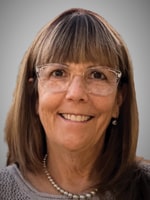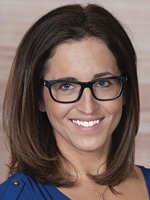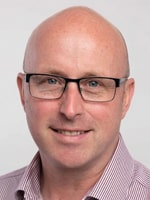December 2022—In September, when CAP TODAY publisher Bob McGonnagle met with pathologists and representatives of companies to talk about laboratory information systems (“Lab information systems—where the needs are greatest,” https://bit.ly/LIS_112022), they talked also about artificial intelligence—innovations, clinical impact, how much interest there is. That part of their conversation follows.

Dr. Becich
I’ve been struck by how much discussion there is around knowledge theory, machine learning, and artificial intelligence as routes to help us through dilemmas. With biomarkers there was fabulous material on applying information theory to help decide which mutations are actionable and which may not be so important. Mike Becich, give us a few comments on this new ground we’re on and a sense of the hype versus reality.
Michael J. Becich, MD, PhD, associate vice chancellor for informatics for the health sciences; distinguished university professor and chair, Department of Biomedical Informatics, and interim co-director, Pittsburgh Supercomputing Center, University of Pittsburgh School of Medicine: I have a disclaimer: I have an artificial intelligence machine learning company called SpIntellx that uses causal discovery to dissect the important interactions in histologic images and multiplex images. AI and machine learning holds great promise not just for research on biotech drug discovery, but for the practicing pathologist. We believe that explainable artificial intelligence is the key to pathologist adoption. We have spent five years working on a set of intellectual property developments and machine learning tools to dissect the complexity of whole slide imaging, now that that is launched as a part of pathology practice. How do you integrate this into a knowledge engineering cockpit, as Bob alludes to, in the framework of the imaging being off to the side or in a picture archiving and communication system but not be part of our LIS strategy. It’s important we take the approach that was taken a long time ago in cytology; with the complexity of pathology calls that anatomic pathologists make, we need to feed the most important areas to them in an intelligent triage so they can quickly make diagnoses on the staggering volume they face. That will be the first major innovation in the space.
The second set of innovations is that anatomic pathology is still handcrafted compared with clinical pathology, and intelligent triage of caseload material is critical. All cases that have a new cancer diagnosis should get sorted to the front of the queue and looked at first, and cases that are confirmational or margins assessment or affect a patient’s stay in the hospital need to be filtered next—not only for cancer but also for inflammatory diseases, transplant, infectious diseases. Right now, pathologists get a stack of glass slides in a tray and there’s no way to intelligently sort and triage that to effective communication. So we’re interested in making sure pathologists have the best tools.
You know what the real problem with most LISs is? You can’t search the tremendous amount of data we collect as pathologists in the same way we can step over to our browser and look something up. A more important place for AI and machine learning to help the LIS industry is to enable search. We have billing and transaction systems; we don’t have search and find in the pathology LIS.
Carol Ross, we know there’s a huge shortage of pathologists in the United States and outside the U.S. Are machine learning and artificial intelligence key factors going forward for Clinisys-Sunquest?

Ross
Carol Ross, MBA, director of product management, Clinisys: We heard a lot at the AACC meeting about machine learning and different uses, including interesting things at the University of Pittsburgh with its laboratory. It is a focus for us now. We are exploring with our customers how we can create the right application programming interface to use that information and be able to feed it back to them within the LIS, for the laboratory-specific ones. Lee can talk about it from a global perspective.
Lee Webb, global product line manager, clinical lab products, Clinisys: We are seeing a drive for machine learning, AI tools. There is a dependency on digital pathology being in place, and there are barriers to adopting digital pathology. I’m looking forward to the day when machine learning and AI image analysis can be used as part of the LIS workflows where, to Dr. Becich’s point, you can run the algorithms across the slides and then start to provide a level of interpretation or prioritization before the pathologist sees the case. There are many areas in the LIS where we think using AI and image analysis outputs would benefit the workflows, for the laboratory and for the pathologist, and we’re seeing that globally.
Dayna Carlin, is there a lot of discussion from clients about the future of machine learning and artificial intelligence, particularly as it relates to developments in your software and your offering?

Carlin
Dayna Carlin, marketing director, NovoPath: Our clients ask about it every day—what do you know about it? How do you integrate it? Who do you integrate with? Who do you recommend? NovoPath helps by creating an ecosystem with our selected partners and leading our clients through a phased approach that takes them to AI—first by optimizing their workflows and lab management, then introducing digital pathology into the workflow, and ending with AI. By creating our partner ecosystem, we’re giving our clients a reliable source of tools and a true partner to provide a solution that puts the lab ahead of its competitors.
NovoPath is built to seamlessly integrate into any scanner or AI tool out there. Now some labs are moving faster than others; some have legacy infrastructure in place and can’t do it as fast as they want to. And there are pathologists who don’t want to use it, so it’s an interesting time, as we are faced with several adoption challenges outside and inside the lab.
Matt Modleski, is this a subject that comes up frequently in the Orchard base?

Modleski
Matt Modleski, executive vice president of corporate/business development, Orchard Software: Dayna hit on a key element of adopting change. All the things we’ve talked about—reports, integrating information, the way I want to look at something—if we had 15 pathologists, they’d want 15 different views. Once you start hardcoding things, then you get one, two, or myriad views. With what Dr. Becich is doing, when you train new pathologists that this is the way to be your best, it increases adoption. If we’re pushing from the top down, it’s hard to get uptake. But there is tremendous interest.
Mark Tuthill, is it correct to assume there’s a Gaussian distribution of interest in these things?
J. Mark Tuthill, MD, division head, pathology informatics, Henry Ford Health System: It’s true, although people are becoming more aware of it. It depends on your practice specialty. For example, people in breast pathology and hematopathology are more tied to molecular testing and therefore are interested in algorithms, image analysis, artificial intelligence.
What does the Henry Ford administration think about efforts along this line in what I know is a constrained financial world for most pathology operations?
Dr. Tuthill (Henry Ford): Coming out of the pandemic, capital is extremely limited. But we are trying to recognize where AI and machine learning have the most direct clinical impact. For us, it’s not a question of doing it for the sake of doing it—it’s for the sake of improving care outcomes and decreasing costs.
I think there will be a willingness to capitalize on machine learning as we start to look at situations in which the technology has direct impact. Our cancer center is behind it. Having clinical champions is key—this is who you partner with and how things come to fruition. The head and neck surgeon who reads about tumor-infiltrating lymphocytes will start to ask for image analysis on specimens. We can lead them there, but they must demand the technology.
If you look at the impact and direct outcomes of precision medicine on patient testing, it’s still fairly nascent. We look at our triple-negative breast cancer markers, and it’s not that prevalent a situation. When we looked at people doing whole exome sequencing, for example—because we have people who don’t use our molecular lab; they go to for-profit molecular labs that offer free testing—and analyzed 500 of those patients, we did not find one positive change in care based on that testing.
Jonathon Northover, how do you assess the questions about machine learning and artificial intelligence and automation? One of the things the laboratory labor shortage has created is demand at sites that don’t necessarily have the scope or size of large institutions, like UPMC or Henry Ford. Is that correct?
Jonathon Northover, vice president of product management, CompuGroup Medical: That’s correct. However, while there is some overlap with what we’ve been hearing about [on this call], most of our clients exist in a separate world. In terms of AI being able to be predictive with regard to throughput and staff management, we have applications to handle some of that. But the priority for some of our larger cancer center clients, for example, is not AI but figuring out the day-to-day challenges, such as how to have a consolidated report or, now that they’re doing more complex tests, how to get flow cytometry, FISH, or NGS up and running.
And contrary to the points made earlier, instead of looking for a software-as-a-service or cloud-based solution, some clients want an on-premise solution that isn’t at risk of being switched off if there’s a problem contractually, so they maintain ultimate control over keeping the system running 24/7. SaaS can represent the risk of handing over too much control to the vendor.
Overall, we haven’t had a lot of AI in independent labs, even in the more sophisticated cancer centers. Other than perhaps with triage—we have a couple of clients who have built their own bots to more efficiently triage patients in physician offices. And from a patient portal perspective, being able to guide the user through a series of messaging and voice interactions to get to their results online. It’s not entirely vaporware, but it doesn’t exist in the market because most of our clients are worried about the on-the-ground management of bringing in new tests and handling the 2,000-percent drop in COVID samples.

Webb
Lee Webb, can you give us background on the merger between Clinisys and Sunquest? What can the Sunquest user base expect to see in the next two years?
Lee Webb (Clinisys): The merger was announced in January 2022, and it’s the coming together of Sunquest and Clinisys, which is a European-based organization. And, following the acquisition of two LIMS providers, we are expanding our offerings into the entire health care setting, not just diagnostic laboratories but also into surveillance of food, agriculture, water. We’re looking at consolidating our expertise and continuing the support and development of our existing products while looking at new opportunities and coming together onto a new single platform.
Many of us on this call and many of our readers had a long history with Sunquest, and I’d be remiss if I didn’t mention that we lost Dr. Sidney Goldblatt, a founder of Sunquest, in January 2022. He was one of the great pioneers in pathology informatics. Mike, as the founder of the Association for Pathology Informatics and the Pathology Informatics Summit, can you share a few comments about Dr. Goldblatt?
Dr. Becich (UPMC): Sid was a dear friend and the true early innovator to launch all the businesses that are represented here today. Sid was from Johnstown, Pennsylvania. In his private practice laboratory, he conceived and launched the first electronic system in all of medical reporting. We were proud to offer Sid our Lifetime Achievement Award through the Association for Pathology Informatics. And Sid regularly tortured me with what I needed to do to carry the baton even a little further. I don’t think I’ve done Sid or Sunquest or the rest of the LIS industry nearly enough service, so I stand ready to attend to Sid’s call for me to act going forward.

Dr. Tuthill
Mark, can you comment on the Association for Pathology Informatics? What are your hopes at API for the role the vendors can play?
Dr. Tuthill (Henry Ford): There was tremendous energy at the ’22 Pathology Informatics Summit. There were calls to action around artificial intelligence and machine learning in anatomic pathology as well as the clinical laboratory. There was also a lot of discussion around leveraging business and data analytics in the diagnostic laboratory. The meeting depends on our exhibitors and vendor partners—they bring these ideas to life with us, and we value their participation in the meetings.
The API is stronger than it’s ever been. We crossed our thousandth member—it’s taken almost 15 years to build up to that level. We have a great organization and a lot of new leadership bringing these ideas to light. API has been putting effort into regulatory requirements and government policy-making, including interacting with the FDA and the federal government at several levels because of changes in regulations around lab-developed tests. This will impact all of us and how we use our laboratory information technology. If some of these rules go through, people won’t need to worry about what they’re going to do with their COVID equipment—it may become obsolete.
 CAP TODAY Pathology/Laboratory Medicine/Laboratory Management
CAP TODAY Pathology/Laboratory Medicine/Laboratory Management
